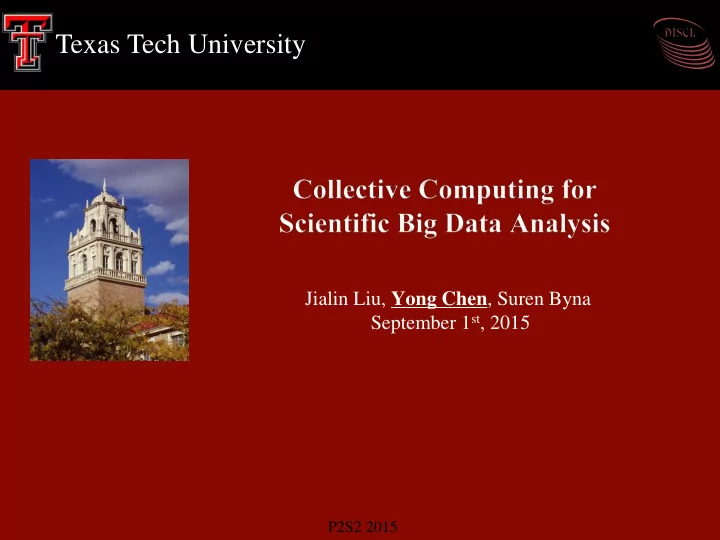

Texas Tech University Jialin Liu, Yong Chen , Suren Byna September 1 st , 2015 P2S2 2015
Outline Introduction Motivation Two-Phase Collective I/O Map-Reduce Computing Framework Collective Computing Framework and Preliminary Evaluation Object I/O and Runtime Support Map on Logic Subsets Result Reduce and Construction Conclusion, Ongoing, and Future Work 2/16 P2S2 2015
Science Data Challenge Scientific simulations/applications have become highly data intensive Data-driven scientific discovery has become the fourth paradigm after experiment, theory, and simulation Data Requirements for Applications (2009) Project On-Line Off-Line FLASH: Turbulent Nuclear Burning 75TB 300TB Reactor Core Hydrodynamics 2TB 5TB Computational Nuclear Structure 4TB 40TB Computational Protein Structure 1TB 2TB Performance Evaluation and Analysis 1TB 1TB Kinetics and Thermodynamics of Metal 5TB 100TB Climate Science 10TB 345TB Parkinson's Disease 2.5TB 50TB Plasma Microturbulence 2TB 10TB Lattice QCD 1TB 44TB Thermal Striping in Sodium Cooled Reactors 4TB 8TB Gating Mechanisms of Membrane Proteins 10TB 10TB Source: R. Ross et. al., Argonne National Laboratory 3/16 P2S2 2015
Science Data Challenge (cont.) Collected data from instruments increases rapidly too Large Synoptic Survey Telescope capturing ultra-high-resolution images of the sky every 15 seconds, every night, for at least 10 years. More than 100 petabytes (about 20 million DVD, 4.7GB each) of data, 2022 Source: LSST 4/16 P2S2 2015
Processing Data in HPC HPC architecture, hierarchical I/O stack Traditional HPC: powerful compute nodes, high speed interconnect (e.g IB), petabytes storage, etc. HPC I/O stack: scientific I/O libraries (e.g HDF5/PnetCDF/ADIOS), I/O middleware (MPI-IO), file systems (Lustre, GPFS, PVFS, etc.) Applications Compute Nodes High Level I/O Libs I/O Middleware Interconnect Network Parallel File Systems RAID Storage Nodes HPC Architecture HPC I/O Software 5/16 P2S2 2015
Processing Data with Collective I/O Traditional Two-Phase Collective I/O Non-contiguous access Multiple iterations p0 p1 p2 p0 p1 p2 Process p0 p1 p2 Storage Computation I/O Phase Shuffle Phase Problems Traditional HPC: Move data from storage to compute nodes, then compute Collective-IO: Computation start only when data are completely ready in memory 6/16 P2S2 2015
Processing Data with MapReduce MapReduce Computing Paradigm Map step: Each worker node applies the "map()" function to the local data Shuffle step : Worker nodes redistribute data based on the output Reduce step: Worker nodes now process each group of output data, per key, in parallel. Similarity vs Difference 7/16 P2S2 2015
Collective Computing: Concept Collective Computing Collective I/O + “MapReduce” Insert computation into I/O iterations p0 p1 p2 p0 p1 p2 Process p0 p1 p2 Storage Computation I/O Phase Shuffle Phase Ok time Ok 8/16 P2S2 2015
Collective Computing: Design Challenges Represent the computation in the collective I/O Collective I/O is performed at byte level, reveal logical view Runtime support Others: computation balance, fault tolerance Proposed Solution and Contribution Break the two-phase I/O constraint and form a flexible collective computing paradigm. Propose object I/O to integrate the analysis task within the collective I/O. Design logical map to recognize the byte sequence. 9/16 P2S2 2015
Collective Computing: Design Object I/O Traditional Collective I/O Object I/O 10/16 P2S2 2015
Collective Computing: Design Runtime Support Collective Computing Runtime The object I/O is declared in high-level I/O libraries, and passed into MPI-IO layer 11/16 P2S2 2015
Collective Computing: Design Map on Logical Subsets Results Reduce and Construction All-to-One All-to-All 12/16 P2S2 2015
Evaluation Experimental Evaluation Cray xe6, Hopper, 153216 cores, 212 terabytes memory, 2 petabytes disk MPICH 3.1.2 Benchmark and applications, WRF, synthetic datasets, 800 GB Computation: statistics, e.g., sum, average, etc Speedup with Different Computation IO Ratio 13/16 P2S2 2015
Evaluation Experimental Evaluation WRF model test Storage overhead 120 MetaData Overhead (MBs) 90 60 30 1 4 8 12 24 MPI Collective Buffer Size (MBs) Storage Overhead WRF Model Test 14/16 P2S2 2015
Conclusion, Ongoing, and Future Work Related Work Nonblocking Collective Operations Combination of MPI and Mapreduce Conclusion Traditional collective IO can not conduct analysis until the I/O is finished. Collective computing intends to provide nonblocking computing paradigm Breaks the two-phase I/O constraint: object I/O, logical map, runtime 2.5X speedup Ongoing and future work Balance computation on aggregator Fault tolerance, handling loss of data and intermediate results 15/16 P2S2 2015
Q&A Thank You! For more info please visit: http://discl.cs.ttu.edu/ 16/16 P2S2 2015
Recommend
More recommend